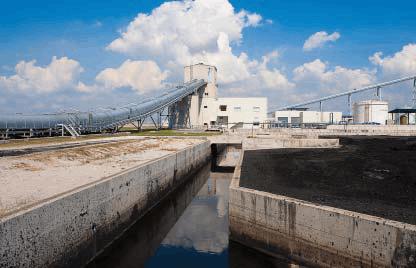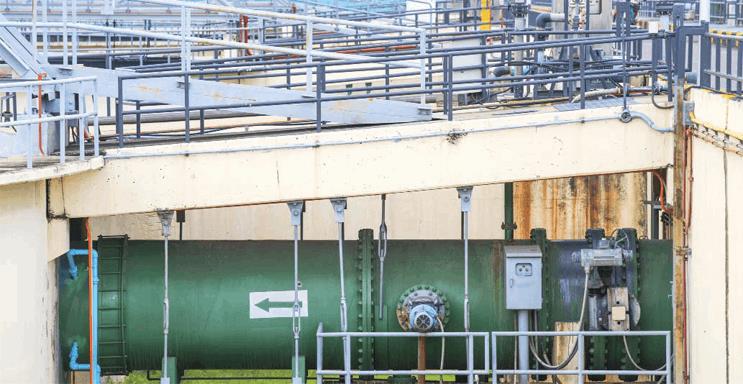Best Practices For Grit Sampling And Characterization
By Hany Gerges, Ph.D., PE
The science behind grit removal is an all-important but underserved aspect of wastewater treatment operations — until now.
Performance of grit removal units at water resource recovery facilities (WRRFs) (also known as wastewater treatment plants) has been evaluated by many wastewater practitioners and the subject of many debates in the wastewater industry for the last two decades. Lack of understanding of the nature of the grit and its settling velocity has led to unsatisfactory performance of many installations in recent years. In many situations, litigation was the only way to resolve a performance dispute between equipment manufacturer, the consulting engineer, and the end user.
While the wastewater industry has generally made great progress in the area of treatment technologies, very slow progress has been realized in the area of grit removal. Recent advancements in design of biological treatment systems have led to very low effluent nutrient concentrations from WRRFs, yet the industry is still struggling to define best practices for designing effective grit removal systems.
There are many current grit removal systems in the marketplace that can remove a wide range of grit particle sizes, but their removal efficiencies vary widely. Some can effectively remove the very fine particles, while others remove the heavier particles but are less effective at removing the fine ones. The decision of which particle size to remove should be site-specific and depends on many factors, among which are the size of the WRRF, the variability in the incoming flows, the downstream liquid processes and their ability to capture escaping grit, and the adverse effect of uncaptured grit on equipment and liquid and solids handling processes. Selecting grit removal systems that remove the very fine particles without consideration of these factors will lead to overbuilding of unnecessary units that may not be utilized most of the year. On the other hand, selecting grit removal systems that remove only the heavy particles could lead to an undersized system and unsatisfactory performance most of the year.

What goes in has great bearing on wastewater treatment equipment.
Getting Grit Right
The most effective grit removal system for a specific WRRF removes only the grit that would cause problems for the downstream processes at this facility all year round. The first step in selecting this system is for the wastewater practitioners to determine the nature and quantity of the grit the facility receives. In other words, practitioners need to determine grit particle distribution and estimate the amount of fine grit versus heavy grit in the incoming flows to select the appropriate grit removal system.
To determine the amount, nature, and distribution of grit particles, industry-standard grit sampling and characterization techniques should be applied. Until recently, there was no industry-standard, peer-reviewed, or widely accepted reference for techniques used in sampling and characterization of grit. In 2014, a task force was formed by the Water Environment Federation (WEF) to study the topic and make recommendations to address the issue. The task force developed and published the first grit sampling and characterization manual, Guidelines for Grit Sampling and Characterization, 2016. The publication was based on industry consensus and prepared and coauthored by industry experts representing utilities, consulting engineers, equipment manufacturers, and academia. It provides the wastewater practitioner with background information that is essential to understand the grit removal process, including removal from liquid streams, washing of grit slurry, and recovery of organics. It clearly identifies the roles and responsibilities of all parties interested in the characterization and sampling of grit, including WRRF staff, consulting engineers, testing companies, and equipment manufacturers. With full understanding of the roles and responsibilities of each party, future grit removal systems will be more efficient and cost-effective, and legal litigation could be avoided.

Input raw water pipeline travels to the solid contact clarifier tank.
The publication covers in detail all sampling techniques that have been used over the last decades. It provides a full description of each method, including safety requirements, testing preparation, sampling locations, sampling equipment, sampling procedures, and collection of samples. It also provides the practitioner with a thorough comparison between the different sampling techniques.
In the characterization chapter, full description and discussion of both dry and wet sieve analysis are presented. The publication addresses all aspects of grit characterization, including pretreatment, determination of settling velocity using different techniques, and state-of- the-art techniques for characterization such as particle imaging.
Out With The Old, In With The New
Until recently, grit characterization was conducted by performing sieve analysis of dry samples of the grit (dry sieve analysis). A decade ago, wastewater practitioners didn’t differentiate between dry and wet sieve analysis, and grit was characterized based on grit particle size (or mesh size), regardless of the settling velocity of the particle. It was assumed that grit particles are all round, have a specific gravity of 2.65, and that the settling velocity will depend on the size of particle. Wilson (2007) and McNamara et al. (2009) challenged that assumption and argued that “actual” grit particles settle at much slower velocities than dry particles with a specific gravity of 2.65. The argument was that grit particles, while traveling in the collection system, entrain or get covered with a layer of fats and oil that cause the particles to be lighter and their specific gravity to be less than 2.65. However, when particles are placed in the oven as part of the dry sieve analysis procedures, the fat and oil layer is removed. Recent work at many treatment plants proved that the grit particles have a settling velocity slower than what had been predicted assuming a specific gravity of 2.65.
The publication also includes equations for calculating the quantity of grit received and removed by the WRRFs for liquid and solids streams. It discusses the sand equivalent size of grit particles and conversion of actual size to equivalent size and its relationship to settling velocity. It also presents current challenges and knowledge gaps, future research, and requirements for grit removal.
Guidelines for Grit Sampling and Characterization not only sets the rules for performing grit sampling and characterization, it also paves the road for achieving optimal grit removal through innovative technologies built on the accurate estimation of grit quantities and full understanding of its fate — making it a “must have” for every wastewater practitioner.
About The Author
 Hany Gerges, Ph.D., PE, has more than 26 years experience in wastewater treatment engineering. His experience has included evaluation, optimization, and design of wastewater treatment plants, including headworks and grit removal technologies. He has also served as HDR’s technical advisor for many national and international wastewater authorities in the area of headworks and grit removal. Dr. Gerges is HDR’s technical director of wastewater optimization services, based in the Walnut Creek, CA office. He was one of the primary authors of Guidelines for Grit Sampling and Characterization (WEF, 2016; www.wef.org).
Hany Gerges, Ph.D., PE, has more than 26 years experience in wastewater treatment engineering. His experience has included evaluation, optimization, and design of wastewater treatment plants, including headworks and grit removal technologies. He has also served as HDR’s technical advisor for many national and international wastewater authorities in the area of headworks and grit removal. Dr. Gerges is HDR’s technical director of wastewater optimization services, based in the Walnut Creek, CA office. He was one of the primary authors of Guidelines for Grit Sampling and Characterization (WEF, 2016; www.wef.org).
